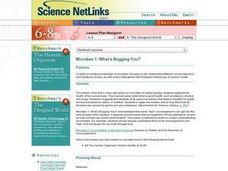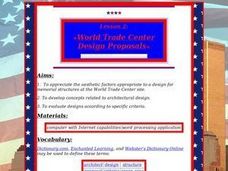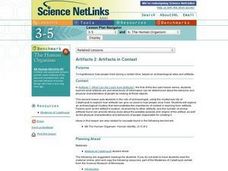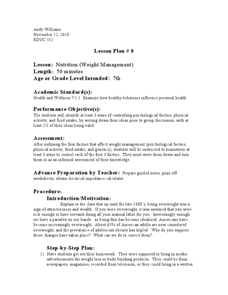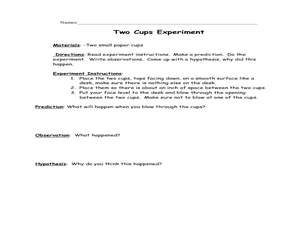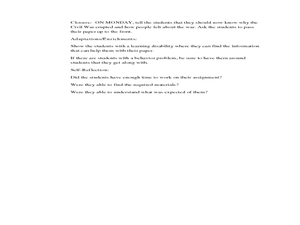Curated OER
Microbes: Louis Pasteur - A Microbe Discoverer
Students study Louis Pasteur and the process of pasteurization in controlling microbes. In this pasteurization lesson, students discuss microorganisms and how they can affect health. They discuss Louis Pasteur and research his work by...
Curated OER
Multiplying Polynomials using the Distributive property.
Students factor polynomial functions. In this algebra lesson, students solve problems through factoring and distribution of the negative sign correctly.
Curated OER
Buoyant Boats
Students design and construct a boat out of aluminum foil and a few other simple materials. The boats then be tested by floating them in water, then adding mass until they sink. They explore the various shapes of boat construction.
Curated OER
Sink or Float?
Students make and test predictions about sinking and floating, and classify objects according to whether they sink or float.
Curated OER
MICROBES 1: WHAT'S BUGGIN YOU?
Students use existing knowledge of microbes, focusing on the relationship between microorganisms and foodborne illness, as well as the implications that foodborne illness has on human health.
Curated OER
Images of the American Revolution
Students analyze several documents as they research the Revolutionary War. They evaluate documents and examine them for bias and perspective. They use their research to write monologues from the point of view of a famous Revolutionary...
Curated OER
COMPOSTING: WHY BOTHER?
Students explore the composting process and participate in a contest to make the most compost the fastest from the school's kitchen and yard waste.
Curated OER
Ethnic Humor
Students define ethnicity and ethnic group in their own words. In groups, they view comic strips and identify how the strips relate to their family life. Individually, they write their own comic strip about their own ethnic group. To...
Curated OER
Sink or Float?
Students will determine whether various objects sink or float in water. They do not need to explain why objects sink or float. They are rather to be encouraged to observe that the same objects will sink or float every time, i.e., that...
Curated OER
Where are the Dinosaurs?
Students construct their own diorama based on the life of a dinosaur. In this dinosaur lesson, students create models of dinosaurs and dinosaurs' eggs to explore the life cycle of this extinct species.
Curated OER
World Trade Center Design Proposals
Learners explore architectural design. In this critical thinking and architecture lesson, students view a number of websites providing proposals for design plans of a new World Trade Center. Learners choose and evaluate three...
Curated OER
Rainforest Food Chain
Students investigate a rainforest food chain. In this ecology lesson plan, students are shown pictures of plants and list what animals might eat the plants. Students continue to think of what other animals might eat those animals....
Curated OER
Introduction to Calculus
Twelfth graders discuss attitude necessary to be successful in calculus. In this calculus instructional activity, 12th graders review famous quotes about success to help them get motivated to learn and be successful in the classroom....
Curated OER
Water Wars: Responsibility in the Age of Globalization
Young scholars explore the concept of water as a resource and as a human right. In this conservation lesson, students record and chart personal water usage and consumption then brainstorm ways in which to responsibly reduce water waste.
Curated OER
U.S. Involvement in WWI – The Zimmerman Note
Students investigate the significance of the Zimmerman Note. In this World War I lesson plan, students use the provided analysis sheet to analyze the contents of the Zimmerman note and discuss how the note led to U.S. involvement in...
Curated OER
Blast Off!
Fourth graders investigate the third law of motion. In this third law of motion lesson plan, 4th graders explore the forces necessary for a rocket to launch. Students compare and contrast propellant and fuel. Numerous resources are...
Curated OER
Artifacts 2: Artifacts in Context
Young scholars explore world history by completing artifact worksheets. In this archaeology lesson, students identify the importance of finding clues when researching historical information by utilizing artifacts. Young scholars research...
Curated OER
Westward Expansion and the Frontier
Students explore U.S. history by researching a historic map. In this westward expansion instructional activity, students discuss the mystery of the western U.S. in the early 1800's and the impact expansion had on Native Americans and...
Curated OER
Endangered Species - Can We Help Them Survive?
Students, in groups, select an animal that has been identified as endangered and then identify its characteristics. They discuss why the animal has become endangered, evaluate adaptations for its survival and include an illustration.
Curated OER
Nutrition (Weight Management)
Seventh graders explore nutrition and the effect it has by participating in class discussions. In this diet and exercise lesson, 7th graders analyze print advertisements and discuss how unrealistic their expectations are and how...
Curated OER
Supply and Demand
Fifth graders discuss the affects of supply and demand on prices and purchasing habits. Given a scenario, student groups discuss how demand and other factors can affect the price of an object. They predict a change in price dependent...
Curated OER
Understanding Bernoulli's Principle
Fifth graders explain why we fly. In this space science lesson, 5th graders discuss Bernoulli's prinicple and its relation to flight.
Curated OER
Experiencing the Civil War
Eleventh graders examine the Civil War. For this American History lesson, 11th graders investigate the causes, effects, and the lives of people during the Civil War. Students develop a research paper using various...
Curated OER
What is the Function of Each Seed Part in the Growth of a Plant
Sixth graders investigate the parts of a seed by using a digital camera. In this botany lesson, 6th graders plant their own seeds in class and demonstrate the necessary attributes for growing a plant. Students utilize a...






